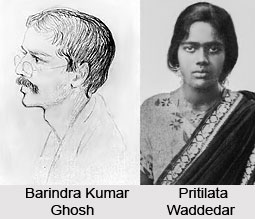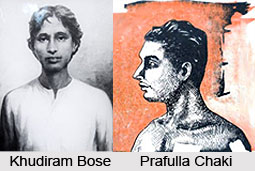 Jugantar means New Era or more literally an Epoch in Transition. It was considered one of the leading terrorist groups in colonial Bengal whose ideology mainly concentrated in the revolutionary activities to free India from British yoke. Anushilan Samiti was started in the semblance of a suburban fitness club. Jugantar was an inner circle within the Calcutta Anushilan Samiti. Barindra Kumar Ghosh and Bhupendranath Datta were the praiseworthy members of Anushilan Samiti with the word of advice of Sri Aurobindo Ghosh initiated in publishing a weekly, Jugantar (New Era) in April, 1906.
Jugantar means New Era or more literally an Epoch in Transition. It was considered one of the leading terrorist groups in colonial Bengal whose ideology mainly concentrated in the revolutionary activities to free India from British yoke. Anushilan Samiti was started in the semblance of a suburban fitness club. Jugantar was an inner circle within the Calcutta Anushilan Samiti. Barindra Kumar Ghosh and Bhupendranath Datta were the praiseworthy members of Anushilan Samiti with the word of advice of Sri Aurobindo Ghosh initiated in publishing a weekly, Jugantar (New Era) in April, 1906.
The group that initiated in publishing of this weekly was the mouthpiece of Jugantar. They started advocating on militant nationalism and thus the group was named Jugantar. Terrorist activities like attempt to murder, assassination and looting against the ruling British government, were carried out by Jugantar. Barindra Kumar Ghosh swore to free India from British colonial supremacy with religious aspirations, tempered by acts of violence. He justified the murders by Ksatriyas to foster happiness of mankind. Along with a revolutionary ardour, he and his twenty-one followers gathered arms and explosives and constructed bombs. That is how they laid the foundation of the terrorist group, Jugantar. 93/A, Baubazar Street was the Headquarters of Jugantar.
Some commendable members of the organisation are-- Aurobindo Ghosh (1872-1950); Barin Ghosh; Raja Subodh Mallik; Khudiram Bose; Prafulla Chaki; Bagha Jatin alias Jatindra Nath Mukherjee (1879-1915); Amarendra Chatterjee (1880-1957); Ambika Chakrobarty (1891-1962); Arun Chandra Guha (b.1892); Basanta Kumar Biswas (1895-1915); Bipin Behari Ganguli (1887-1954); Bhupendra Kumar Datta (1894-1979); Dinesh Chandra Majumdar (1907-1934); Ganesh Ghosh (b. 1900 ); Jadu Gopal Mukherjee (1866-1986); Jiban Lal Chattopadhyay (1889-1970); Jyotish Chandra Ghose (1887-1970); Kalpana Datta Joshi (b.1913); Manoranjan Gupta (b.1890); Pritilata Waddedar (1911-1932); Taraknath Das (1884-1958); Tarakeswar Dastidar; Purna Chandra Das (1889-1956); Santosh Kumar Mitra (1901-1931); Santi Ghose Das ( b.1916); Suniti Chaudhuri Ghosh (b.1917); Surendra Mohan Ghosh alias Madhu Ghosh (1893-1976); Upendra Nath Bandopadhyay (1879-1950); Binod Bihari Chaudhury; Ullaskar Dutta; Debabrata Bose, later Swami Paragyananda; Satyendra Chandra Mitra (1888-1942).
Some members of Jugantar party were also sent abroad for political and military training. Surendra Mohan Bose, Tarak Nath Das and Guran Ditt Kumar were the first ones to leave for training. They were actively involved in the revolutionary activities since 1907 amongst the Hindu and Sikh immigrants on the Western coast of North America. Later, they formed the Ghadar Party. It was Hemchandra Qanungo amongst the first revolutionary generations, who obtained training from a Russian anarchist Nicholas Safranski in Paris along with Pandurang M. Bapat. On January 1908, he returned to Kolkata and linked up with the combined school of `self-culture` (anushilan) and bomb factory run by Barin Ghosh. The factory was located in a garden house in Maniktala, a suburb of Calcutta.
On 30th April, 1908, Jugantar party members Khudiram Bose and Prafulla Chaki attempted to murder Kingsford, the then district Judge of Muzaffarpur. Two innocent English women were killed mistakenly during the endeavour and Khudiram Bose was arrested and Prafulla Chaki killed himself. As a result of this arrest, a police investigation lead to the arrest of many other the revolutionaries. The revolutionaries were linked with the widely known Alipore bomb conspiracy case. Several of them were imprisoned for life in the Cellular Jail in Andaman. As a next step, Jugantar chose to interdict the persons associated with the arrests and trails. On 10th February, 1909, prosecutor Ashutosh Biswas was shot dead by Charu Basu within the Calcutta High Court premises. He was the prosecutor of Kanai and Satyen for the murder of Naren Gosain. Later the Deputy Superintendent of Police, Samsul Alam was also murdered by Biren Dutta Gupta on January 24, 1910 on the stairs of Calcutta High Court building. Samsul Alam dealt with the Alipore Case. However Charu Basu and Biren Dutta Gupta were arrested and hanged.
Jatindra Nath Mukherjee, popularly known as `Bagha Jatin`, along with others were arrested, as they were found to be associated with the Samsul Alam murder case and other charges too. The Howrah conspiracy case was started against them, which adjudicated the prisoners for `treason -- waging war against the Crown and tampering with the loyalty of Indian soldiers, such as those belonging to the Jat Regiment posted in Fort William, and soldiers in Upper Indian Cantonments`. According to Nixon`s Report, Jugantar, under the able guidence of Jatindra Nath Mukherjee weighed a good deal on the resulting World War to unionise an armed insurrection with the Indian soldiers in various regiments.
The Jugntar Party imported German arms and ammunitions, such as the 32 bore German automatic pistols with the help of Virendranath Chattopadhyay alias `Chatto` and other revolutionaries who resided in Germany during that time.
 They also allied with the Indian revolutionaries actively involved in the United States. Jugantar was also associated with the Bolshevik revolutionary Manabendra Nath Roy alias Narendra Nath Bhattacharya in Berlin. Noted Jugantar party member Rash Behari Bose was communicated to take charge of Upper India. The purpose of this move was an All-Indian Rebellion along with the collaboration of native soldiers in different cantonments. This is unanimously known as the German plot in history. During that time Jugantar carried out a series of dacoities to raise funds for working out the Indo-German Conspiracy, which later came to be known as Taxicab dacoities and Boat dacoities.
They also allied with the Indian revolutionaries actively involved in the United States. Jugantar was also associated with the Bolshevik revolutionary Manabendra Nath Roy alias Narendra Nath Bhattacharya in Berlin. Noted Jugantar party member Rash Behari Bose was communicated to take charge of Upper India. The purpose of this move was an All-Indian Rebellion along with the collaboration of native soldiers in different cantonments. This is unanimously known as the German plot in history. During that time Jugantar carried out a series of dacoities to raise funds for working out the Indo-German Conspiracy, which later came to be known as Taxicab dacoities and Boat dacoities.
The first Taxicab dacoity took place on February 12, 1915 in Garden Reach, Kolkata under the leadership of Narendra Bhattacharya. The movement took place under the strict supervision of Jatindranath Mukherjee. On different other occasions similar kinds of dacoities were conducted in various parts of Calcutta. Later Jatindra Nath Mukherjee sent Naren Bhattacharya (alias M. N. Roy) and Phani Chakravarti (alias Pyne) to attend the meeting with German legation at Batavia. In the meeting it was decided that German arms would be delivered at two or three places like Hatia on Chittagong coast, Balasore in Orissa and Raimangal in the Sunderbans. Jugantar was about to unionise a guerrilla force to start a rebellion within the country, supported by a mutiny among the Indian Armed Force. But destiny had something else in store for them. The whole plot was leaked out and police of the delta region of Ganges became alert. They sealed off all the sea approaches of the eastern coast. The police also managed to find out the hiding places of Bagha Jatin and his associates. A gun fight took place there and as a result many revolutionaries were either killed or arrested. Thus the German plot failed miserably.
The successive death and arrest of some pioneer leaders of the Jugantar party created a vacuum within the party members. As a result the party separated into two groups. Dhaka Anushilan Samiti in East Bengal did not take part in the Indo-German plot that Jugantar in Western Bengal encouraged. In 1920 Jugantar leaders decided to set aside all violent actions and followed on the path of the Non-Cooperation movement proposed by Gandhi. But Dhaka Anushilan Samiti sustained its terrorist programme by foraying into post offices, railway cash offices, etc., to build up funds. Many of the leaders were given high positions in Bengal`s district and Provincial Congress Committees and even in the national committees. The offices of the Secretary and Assistant Secretary of the Bengal Provincial Congress Committee was held by Bhupati Majumder and Monoranjan Gupta respectively.
Other members of Jugantar, such as Amarendra Chatterjee, Upendranath Banerjee, Bipin Behari Ganguli and Satyendra Chandra Mitra were also elected to the All India Congress Committee from Bengal. Later in 1927, Satyendra Chandra Mitra was appointed the Chief Whip of the Swarajya Party in the Central Legislative Assembly (present-day Parliament). In 1937, Mitra became the President of the Bengal Legislative Council (of undivided Bengal). In May 1930, the main Jugantar Party in Calcutta straightened up a programme of terrorism and made arrangements for the manufacture of bombs. The main features of this programme included- (a) murder of Europeans in hotels, clubs, and cinemas; (b) burning of the Dum-Dum (Calcutta) aerodrome; (c) disrupting of the gas and electricity supply of Calcutta by destroying the gas works and the electric power stations; (d) cutting off the petrol supply of Calcutta by destroying the depot at Budge-Budge; (e) disorganisation of tramway services in Calcutta by cutting overhead wires; (f) destruction of the telegraphic communication between Calcutta and other districts of Bengal; and (g) destruction of bridges and railway lines by dynamites and hand grenades.
Later, the Anushilan Samiti and Jugantar were brought closer under the joint leadership of Narendra Mohan Sen of Anushilan, represented by Rabindra Mohan Sen and Jadugopal Mukherjee of Jugantar, represented by Bhupendra Kumar Datta. But the merger failed. This failed merger disappointed the younger generation of the revolutionaries. In 1929 they formed a new confederation, the Neo-violence party. The scenario changed with the passing years as the British government were planning to quit India.The reason behind such designs were the communal and religious politics that were in vogue in India. The basic political backdrop on which the revolutionary ideas were constituted, appeared to channelise towards a new direction. Thus the Revolutionary Terrorism can be said to have culminated by 1936. On 9th September 1938, the Jugantar officially merged with the Congress.



















